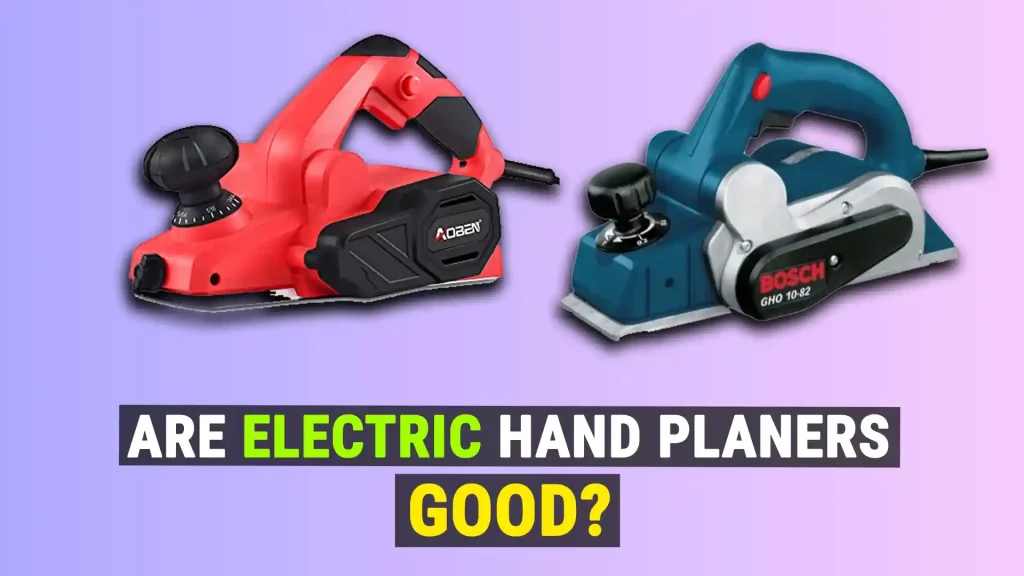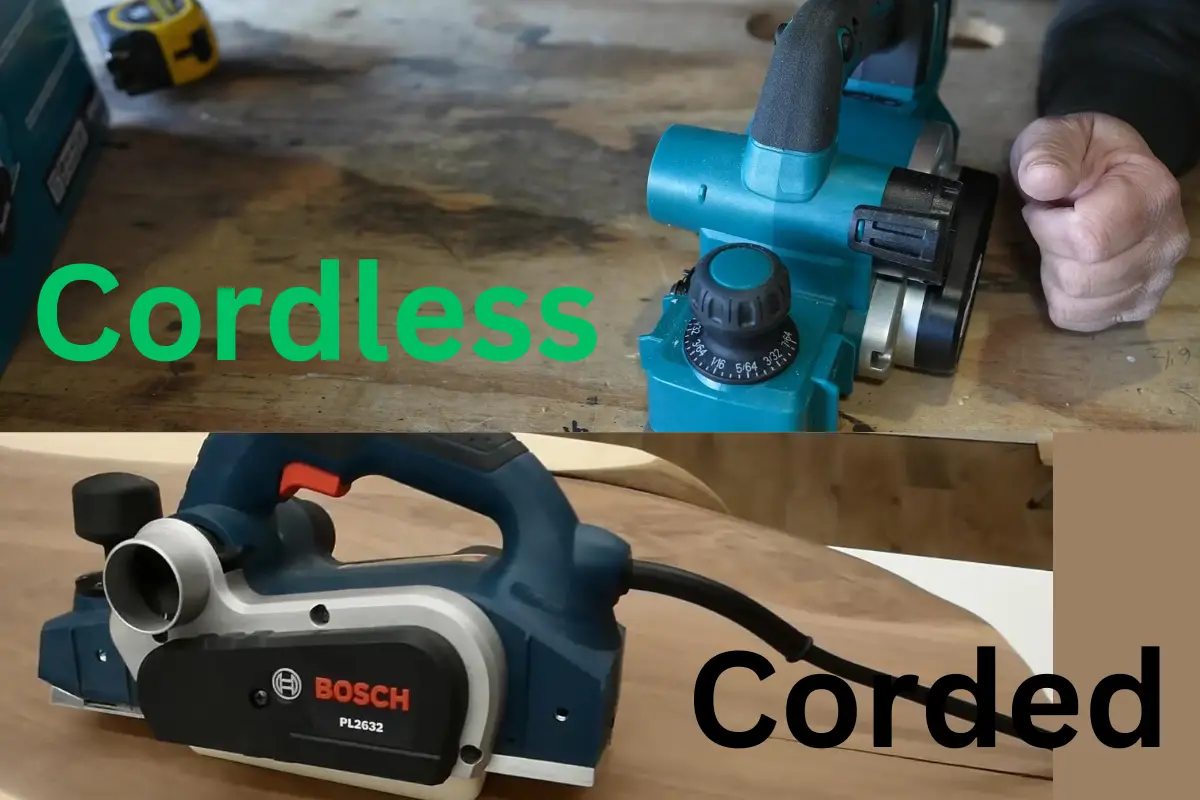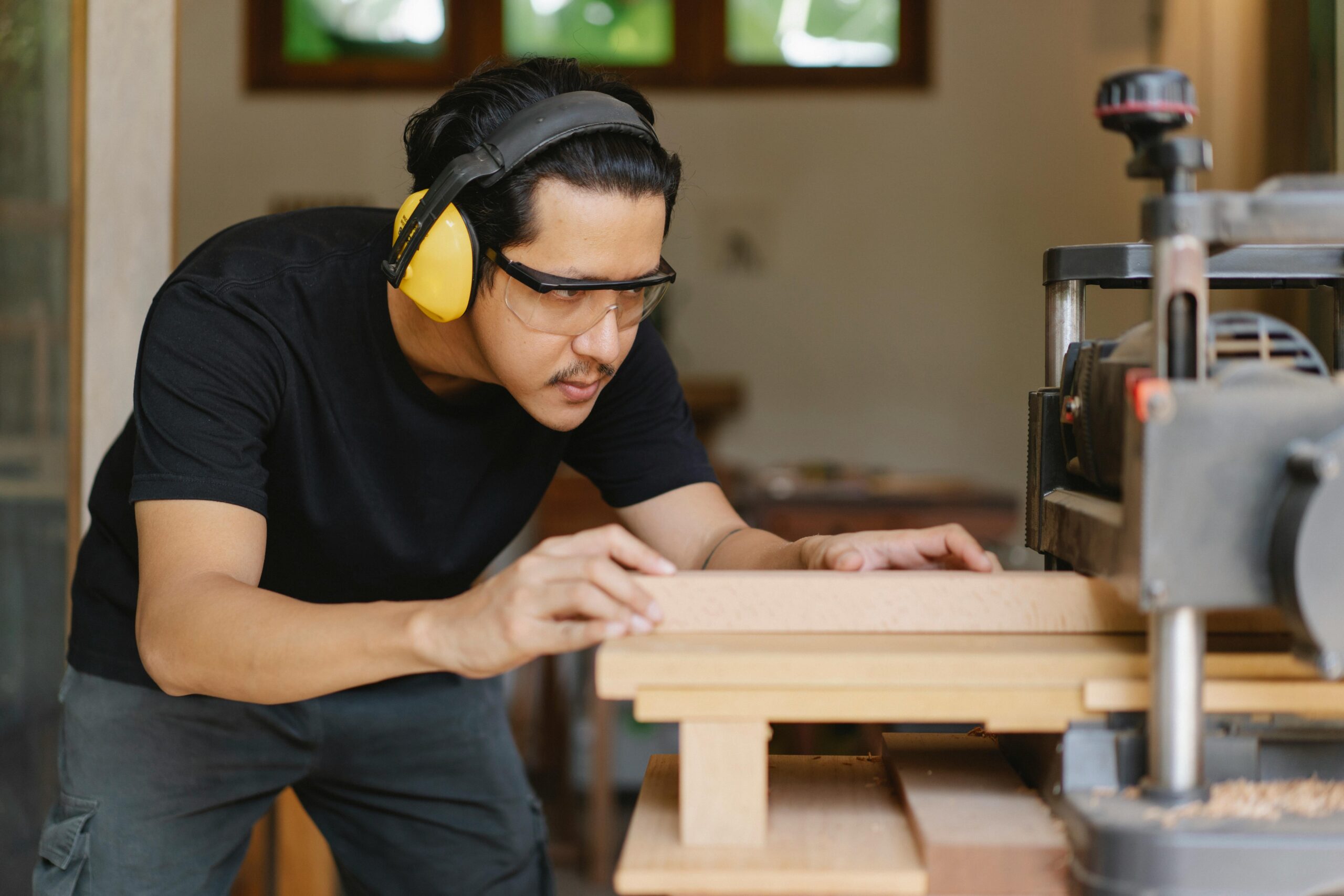Are Electric Hand Planers Good? [Answered]
An electric hand planer, also known as a power planer, is a handheld woodworking tool used to smooth and level wood surfaces. As the name suggests, it is powered by electricity, usually via a cord that plugs into an outlet.
Key features of electric hand planers:
- Portability – They are lightweight and compact, designed to be used with one hand. This makes them very maneuverable for working on smaller projects.
- Electric motor – The cutting blade is powered by an electric motor which can operate at very high rpm for fast stock removal. This allows them to smooth and level wood faster than manual hand planes.
- Depth adjustment – There is a depth adjustment knob that allows you to control the depth of cut, usually in increments of 1/128″. This enables precise control over how much material is removed in each pass.
- Dust extraction – Most models have a dust port that connects to a vacuum to extract wood chips and dust while you work. This keeps the work area cleaner.
- Cutting blades – The cutting blades are usually double-edged and reversible. When one side gets dull you can flip the blade to use the other sharp edge. Some models have carbide tipped blades for extended edge life.

Advantages of Electric Hand Planers
Electric hand planers have several key advantages that make them a useful addition to any woodworking toolkit:
Speed and Efficiency
The motorized operation of an electric hand planer allows it to quickly and efficiently remove material. Whereas a regular hand plane relies solely on manual effort, the electric planer uses electricity to spin the blade at up to 16,000 rpm. This high speed allows you to rapidly smooth and flatten surfaces in a fraction of the time of a traditional hand plane. A few passes is often all it takes to uniformly level a rough piece of lumber.
Versatility
An electric hand planer can perform multiple tasks – not just planing wide surfaces but also trimming edges, chamfering, and other detail work. The compact size and one-handed operation gives you excellent control and maneuverability to plane smaller pieces. The depth adjustment knob also provides the precision to fine tune cuts.
Convenience
Electric planers are very convenient tools to use. They only require plugging into an electrical outlet to operate – no manual labor or sharpening needed. The power feed mechanism draws the tool along the wood, minimizing the physical effort required. The dust extraction also keeps your workspace tidier. Overall, an electric hand planer is an easy, user-friendly tool even for beginners.
Affordability
Electric hand planers are one of the more budget-friendly power tools. Basic models can be purchased for under $100. When you consider the potential time and effort saved compared to using a regular hand plane, the electric planer offers great value for money. Investing in an electric planer is an affordable way to increase productivity in your woodworking.
Disadvantages of Electric Hand Planers
However, electric hand planers also come with some downsides to consider:
Increased Tear Out
The high speed of the motorized blade can sometimes cause splintering or chipping in the wood surface. The tear out is minimized at slower feed rates but may still be more prevalent than with a traditional hand plane, especially in wood with changing grain patterns. This requires additional sanding to smooth the surface.
Not as Precise
It is more difficult to get a perfectly flat surface with an electric hand planer. Technique and feed speed impacts the consistency of the cut. The fixed planing depth also limits fine tuning. For precision work, a traditional hand plane may still be superior.
Dust Creation
The electric blades remove a lot of material quickly, which also creates a lot of wood dust and chips. Some dust extraction will be needed to avoid making a mess. The required vacuum adds an additional expense and hassle factor.
Learning Curve
Proper technique is required to move the electric planer correctly and avoid uneven surfaces. Novices may find the tool unwieldy at first. Mastering feed speed and direction takes practice to get professional results. There is a learning curve to using electric planers effectively.
Not for Large Surfaces
The relatively small size of the planer base makes it unsuitable for smoothing wide surfaces. You are limited to working on narrower boards. Flattening large tabletops and other big projects is better done with a benchtop thickness planer.
Top electric hand planers For 2023
| Model | Type | Power | Price |
|---|---|---|---|
| DeWalt D26677K | Best Overall | Corded | Check Price |
| WEN 6534 | Best Bang for the Buck | Corded | Check Price |
| Makita XPK02Z | Upgrade Pick | Cordless | Check Price |
| Bosch PL2632K | Best Corded | Corded | Check Price |
| DeWalt DCP580B | Best Cordless | Cordless | Check Price |
| Makita KP0810 | Best Heavy-Duty | Corded | Check Price |
| Ryobi One+ | Best Light-Duty | Cordless | Check Price |
| Porter-Cable PC60THP | Also Consider | Corded | Check Price |
Types of Electric Hand Planers
There are a few different varieties of electric hand planers available:
Standard Planers
The most common type, standard planers are designed for general smoothing, chamfering, and edging tasks. They typically have planing widths around 3-1/4″. Standard planers like the DEWALT DW680K or Bosch PL1632 provide a good balance of power, precision, and versatility for most users.
Narrow Planers
As the name suggests, narrow planers have a more compact planning base around 1-3/8″ – 2″ wide. This allows you to plane in tighter spaces, like right up against a wall. However, their power is lower and capacity more limited.
Cordless Planers
Cordless planers run off rechargeable lithium-ion battery packs. The battery power offers unmatched portability and convenience. However, runtime is limited per charge. Models like the Makita XBP02Z have lower power compared to corded.
Benchtop Thickness Planers
For wider surfaces, a benchtop thickness planer like the DEWALT DW735X may be required. The cutter head spans 12-1/2″ to 13″ for planing full-width boards up to 6-8″ thick. But these are larger, less portable machines.
Heavy Duty Planers
Some extra powerful planers are designed for heavier duty stock removal and constant professional use. They have features like metal housing, higher amp motors, and advanced dust collection. But they come at a significantly higher cost.
Key Features to Look For
Here are some of the most important features to evaluate when choosing an electric hand planer:
- Motor power – Measured in amps, higher amperage translates to greater cutting power and speed. Look for planers in the 10-15 amp range for the best performance.
- Cutter head speed – The blade rpm directly impacts planing speed and finish. Speeds around 16,000 rpm are preferred.
- Depth capacity – The maximum cut depth determines how aggressively you can remove material in each pass. 1/8″ is suitable for most work but some models allow up to 1/4″ cuts.
- Dust extraction – Look for a port to attach a vacuum hose. Dust collection is essential for clean work and visibility.
- Weight – Lighter planers around 5 lbs are more comfortable for extended use. But heavier ones usually indicate more power and durability.
- Base width – Standard planers have 3-1/4″ planning widths. Narrower bases like 2″ allow planing in tight spots.
- Blade quality – Carbide-tipped blades last the longest. Double-sided blades effectively double the usable life.
- Depth stop – Allows you to preset cutting depth for consistent thickness planing. A handy time-saving feature.
- Side handle – Provides extra control and safety when planing vertically like edging boards.
Top Electric Hand Planer Brands
Some of the leading electric hand planer brands include:
DEWALT
One of the most popular brands used by professionals. DEWALT planers like the DW680K offer excellent power, precision, and durability. Models come with 3-year limited warranties.
Makita
Renowned for reliability and performance. Makita planers provide superb value for money. The Makita KP0800K is a great example of their well-designed planers.
Bosch
German engineering gives Bosch planers like the PL1632 outstanding quality. They offer very smooth, accurate cuts and thoughtful features. Known for low noise operation.
Ryobi
The more budget-friendly brand for home DIYers. Ryobi offers basic planers like the PL660 that get the job done at a fraction of the cost of pro models.
Metabo
Another German brand producing professional-grade planers known for high motor HP. Excellent for aggressive stock removal but expensive.
Porter Cable
A mid-range brand offering reliable, no-frills hand planers like the PC60THP ideal for most hobbyists. Good balance of price and performance.
Ridgid
Part of the same parent company as Ryobi. The Ridgid R2800 is a basic planer with adequate power for most light-duty projects.
What to Look for When Buying Used
Buying a used electric hand planer can save money, but you need to inspect it carefully:
- Check the condition of the cutting blades – worn, damaged, or dull blades will need replacing.
- Test the planer power and listen for unusual motor sounds that can indicate issues.
- Verify smooth operation of the depth adjustment mechanism.
- Evaluate wear and tear on the housing – cracks or damage can affect performance.
- Try planing a piece of scrap wood to assess cut quality and look for excessive snipe.
- Make sure all necessary accessories like wrenches, blades, dust bag, etc are included.
- Carefully inspect the power cord for any cuts, frays, or exposed wires.
- Consider age of the model – very old planers may not have modern safety features.
- Check for signs of dust and debris buildup which can indicate lack of maintenance.
Buying used can get you significant savings but stick to reputable brands and thoroughly test it first. Factor in the cost of any repairs or replacements needed.
Accessories and Attachments
There are some handy accessories and attachments available for electric hand planers:
- Dust bag – Collects dust and debris for less messy cleanup. Often included.
- Vacuum hose – Attaches to the dust port for extracting dust while working. Keeps the work area cleaner.
- Edge guide – Helps steady the planer against edges for straight chamfers and trim planing.
- Blades – Replacement blades are essential consumables to keep your planer cutting efficiently.
- Guide rollers – Can attach to the base to help slide the planer straighter along wider surfaces.
- Planing jigs – Help hold thinner workpieces steady for planing without tear out.
- Parallel fence – Allows mounting the planer on a fence to widen the planing width.
- Abrasives – Sandpaper cleaning blocks can remove pitch buildup from planer blades.
Maintenance Tips
To keep your electric hand planer performing optimally:
- Regularly clear out dust and debris from the housing and vacuum the motor vents.
- Check and tighten any loose fasteners on the housing or baseplate.
- Lubricate the feed roller bushings as specified by the manufacturer.
- Inspect the power cord for damage and immediately replace if faulty.
- Ensure the blade locking mechanism functions properly for safe blade changes.
- Clean pitch resin buildup from blades frequently for best cutting performance.
- Rotate or change blades as soon as cutting speed slows or finish deteriorates.
- Store with the blades retracted to prevent accidental damage.
- Confirm brush contacts are clean – motor power relies on proper electrical contact.
Proper care will maximize your planer’s lifespan and prevent costly repairs down the road. Always follow the manufacturer’s maintenance guidelines.
Safety Tips
As with any power tool, essential safety precautions should be taken when using an electric hand planer:
- Always wear eye and ear protection – safety glasses and hearing protection help prevent serious injuries.
- Avoid loose clothing, jewelry, or gloves that could get caught in moving parts.
- Make sure the workpiece is secure before starting to avoid loss of control or accidental gouges.
- Keep hands away from the blade and front edge to prevent cuts – don’t plan upwards right at your hands.
- Maintain a balanced stance and firm two-handed grip when planing for best control.
- Ensure adequate lighting and visibility over the work area.
- Double check the depth setting before powering on to prevent overly-aggressive cuts.
- Allow the planer to reach full speed before contacting the wood.
- Unplug when doing any adjustments, maintenance, or blade changes.
- Keep guards in place and don’t modify safety mechanisms.
Understanding basic safety will help you avoid accidents and get the most from your electric hand planer.
Tips for New Users
If you’re new to electric hand planers, keep these tips in mind:
- Take time to review the user manual and familiarize yourself with the controls.
- Start with a scrap piece to get a feel for the planer before doing real work.
- Go slow with shallow passes until you get comfortable with the feed rate and direction.
- Pay attention to grain direction – always plane with the grain to prevent tear-out.
- Empty the dust bag frequently so it doesn’t overload and clog the port.
- Experiment with depth settings to balance cut speed and surface quality.
- Use an edge guide for support when doing trim or chamfer planing.
- Let the planer do the work – don’t apply too much downward pressure.
- Check your work frequently to ensure you are achieving the desired results.
- Plug into a GFCI protected outlet for safety, especially if using cordless models.
The learning curve is short with a little practice. You’ll be achieving professional looking results in no time!
Troubleshooting Common Problems
Here are some potential issues and remedies with electric hand planers:
Rough cuts or excessive snipe
- Cause – Feed rate too fast, blades dull, depth too high
- Fix – Slow down feed rate, change blades, reduce depth
Planer not starting
- Cause – Cord damaged, switch faulty, brushes worn
- Fix – Inspect/replace cord, test switch, clean brushes
Excessive tear-out
- Cause – Cutting against the grain, dull blades
- Fix – Cut with the grain, rotate or change blades
Machine bogs down
- Cause – Blunt blades, overloaded with chips
- Fix – Replace blades, clear debris buildup
Uneven planing
- Cause – Nicks in baseplate, feed speed inconsistent
- Fix – Sand base smooth, maintain steady feed rate
Excessive snipe
- Cause – Starting/stopping in workpiece
- Fix – Start planing before and after workpiece
Machine vibrates/moves
- Cause – Loose housing, damaged components
- Fix – Tighten fasteners, inspect internal parts
Following manufacturer troubleshooting tips can help diagnose and remedy any issues. For stubborn problems, a qualified repair technician may be required.
DIY Projects
Electric hand planers are extremely handy for all sorts of DIY projects around the home and workshop:
Smooth Rough Lumber
Surface, edge, and thickness plane rough sawn lumber to prepare for furniture building.
Trim Doors
Carefully plane doors to clear thick carpets or eliminate scraping on floors.
Chamfer Edge Boards
Add elegant, beveled edges to boards using an edge guide for consistent results.
Plane Thin Stock
Use a planing jig to surface thin boards without tear out.
Level Uneven Surfaces
Quickly flatten misaligned tabletops, cabinets, or other surfaces.
Sharpen Chisels
Carefully flatten the backs of chisels and plane blades on a granite surface.
Clean Up Glue Squeeze-Out
Slice off dried glue drips and residue from wood joints with a light skim pass.
Decorative Effects
Add unique distressed or carved effects by planing the wood surface selectively.
Remove Paint and Finishes
Strip doors, furniture, and other pieces by planing off layers of old finishes.
With a little creativity, an electric hand planer can help complete all kinds of projects!
Conclusion
In summary, electric hand planers provide a versatile, efficient means of smoothing, trimming, and leveling wood. Their portability, ease of use, and affordability makes them accessible for both DIYers and professionals. While manual planes may still hold superiority for fine furniture making, electric planers are hard to beat for speed, convenience, and tackling rough work.
When shopping, focus on finding the right balance of features, power, precision, and price point for your needs. Models from trusted brands like DEWALT, Makita, and Bosch are good go-to options. With basic care and maintenance, an electric hand planer can provide many years of reliable service for any woodworking toolkit. So don’t be afraid to plug in and enjoy the benefits of power planing!




